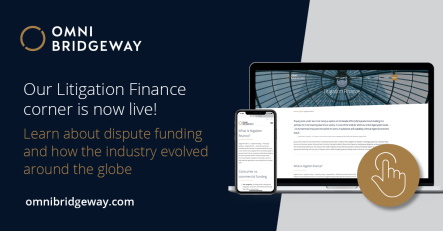A new resource for learning the fundamentals of litigation finance

During the last quarter century, dispute finance has emerged as a powerful tool for claimants, law firms, and companies seeking an alternative means of financing for litigation. And in the last decade in particular, funding of complex commercial cases has evolved and expanded into jurisdictions around the globe.
We are often asked: How does funding work? How do claimants benefit from funding arrangements? How has funding developed in key jurisdictions? To help answer those and other important funding-related questions, we have created a new resource page that covers the basics of litigation finance and tells the story of its development. The Litigation Finance insights page can be accessed here.
As we note in this resource, litigation finance, when distilled to its essence, “provides a means to help make the legal system more accessible on a broader scale.” Funding not only levels the playing field for claimants who may not otherwise be able to pursue highly meritorious claims but also acts as an alternative solution for law firms and companies to pursue meritorious cases in a fiscally responsible manner.
KEY QUESTIONS
Litigation finance can be a complex subject, and the new page addresses several of the issues that often arise in our conversations with claimants and lawyers.
Among the topics we address are:
- How litigation finance is defined: What does “litigation finance” mean and how does commercial litigation funding—which focuses on large cases involving businesses and individuals—differ from consumer litigation funding, which is primarily aimed at providing cash to personal injury plaintiffs? In addition, we explain the various types of funding arrangements in commercial cases, including single-case, portfolio, and multi-party funding.
- The benefits of litigation finance: We explore how non-recourse funding offers an attractive alternative to traditional bank loans and provides flexibility that can allow a funded party or counsel to cover operational expenses, fund other contingency cases, and withstand a lengthy litigation without being forced into a premature settlement. Funding can also unlock the unrealized value of litigation and help improve the corporate bottom line.
- Financial issues. How does non-recourse funding work? How does commercial litigation funding differ from a traditional loan from a financial institution? Are there typical returns? How is risk shared among the funder, claimant, and lawyers?
- What to Expect When Seeking Funding. How does confidentiality work in a funding arrangement? How does a funder gather information and analyze litigation? How do term sheets work? What due diligence does the funder perform? How do funders decide on investments? What is a “litigation funding agreement” (LFA)? How is litigation monitored post-investment?
A HISTORY OF FUNDING
We have also developed a brief history of the evolution of litigation funding—stretching all the way back to the Middle Ages. Third-party financing of lawsuits was once frowned upon because nobles in medieval England had used their wealth to unscrupulously influence litigation. As we note on our new resource page, the common law concepts of maintenance and champerty were enacted to ban such interference in cases.
In the 1990s in Australia, attitudes around third-party funding began to shift. First, in the insolvency context, and later—through a landmark High Court ruling—in single and class-action cases, funding became an accepted part of the litigation landscape.
As barriers fell in Australia, funding was making inroads in other jurisdictions as well. On our new page, you can read more about how funding has grown in common law jurisdictions like England and Wales, and in civil law jurisdictions such as Germany, the Netherlands, Switzerland, and others. We also recount the rapid growth of litigation funding in the United States and Canada, and its expansion into international arbitration forums, including in Singapore and Hong Kong.
To discover more about the evolution of funding and about how modern-day funding works, please visit the new Litigation Finance page. And to learn more about Omni Bridgeway’s litigation funding capabilities, visit our Company Insights. While there, explore our recent podcasts, blog posts, and videos. Or contact us for a consultation to learn more about the ways we can help you pursue meritorious claims.